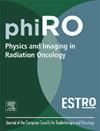Comparison of interstitial high-dose-rate brachytherapy and stereotactic radiotherapy in breath-hold technique for inoperable primary and secondary liver tumors
IF 3.3
Q2 ONCOLOGY
引用次数: 0
Abstract
Background and purpose
In recent years, ablative radiotherapy of primary and secondary liver tumors has become a highly regarded treatment option. We aimed to compare high-dose-rate interstitial brachytherapy (HDR-iBT) and stereotactic body radiotherapy (SBRT) in free breathing (FB) and deep inspiration breath hold (DIBH) in order to support future decisions on the appropriate radiation technique for liver tumors.
Materials and methods
Forty-two patients with 1–4 liver malignancies undergoing HDR-iBT with 1x15-20 Gy were included. Eighty-eight SBRT plans in DIBH or FB with a prescription dose of 3x12.5 Gy to the surrounding 67 % isodose were generated using the HDR-iBT-computed tomography. Dose-volume parameters according to ICRU91 regarding organs-at-risk (OAR), target coverage, generalized equivalent uniform dose (gEUD2Gy), biological dose parameters, dose uniformity, conformity and plan quality indices were compared.
Results
The mean target doses for HDR-iBT were at least twice as high as in SBRT, but target coverage was significantly more conformal for SBRT and the gEUD2Gy was higher (p < 0.001). The healthy tissue conformity indices (HTCI) for SBRTFB and SBRTDIBH were significantly higher than for HDR-iBT (p < 0.001). For all techniques, a significant positive correlation between HTCI and target volume size was found. HDR-iBT achieved lower mean and maximum doses for most investigated OAR-parameters. Comparing SBRTDIBH and SBRTFB, all OAR-parameters presented significantly lower values for SBRTDIBH (p < 0.001).
Conclusion
While SBRTDIBH achieved a more conformal target coverage with both higher minimal doses and gEUD2Gy, brachytherapy offered higher mean and maximal doses to the target volume and a better sparing of OAR, depending on optimal catheter positioning.
间质性高剂量率近距离放疗与立体定向屏气放疗治疗不能手术的原发性和继发性肝肿瘤的比较
背景与目的近年来,原发性和继发性肝脏肿瘤的消融放疗已成为一种备受重视的治疗选择。我们的目的是比较高剂量率间质近距离放疗(HDR-iBT)和立体定向体放疗(SBRT)在自由呼吸(FB)和深吸气屏气(DIBH)中的应用,以支持未来对肝肿瘤合适的放疗技术的决策。材料和方法纳入42例1-4例肝脏恶性肿瘤患者,接受1x15- 20gy的HDR-iBT治疗。使用hdr - ibt计算机断层扫描生成88个DIBH或FB的SBRT计划,处方剂量为3x12.5 Gy至周围67%等剂量。比较ICRU91中有关危险器官(OAR)、靶覆盖率、广义等效均匀剂量(gEUD2Gy)、生物剂量参数、剂量均匀性、一致性和计划质量指标的剂量-体积参数。结果HDR-iBT的平均靶剂量至少是SBRT的两倍,但SBRT的靶覆盖率明显更符合条件,gEUD2Gy更高(p <;0.001)。SBRTFB和SBRTDIBH的健康组织一致性指数(HTCI)显著高于HDR-iBT (p <;0.001)。对于所有技术,HTCI与靶体积大小之间存在显著的正相关。HDR-iBT在大多数研究的桨形参数中获得较低的平均和最大剂量。与SBRTDIBH和SBRTFB相比,SBRTDIBH的所有桨叶参数值均显著降低(p <;0.001)。结论虽然SBRTDIBH在更高的最小剂量和gEUD2Gy下实现了更适格的靶覆盖,但近距离治疗可提供更高的靶体积平均和最大剂量,并更好地保留OAR,这取决于最佳导管定位。
本文章由计算机程序翻译,如有差异,请以英文原文为准。
求助全文
约1分钟内获得全文
求助全文
来源期刊

Physics and Imaging in Radiation Oncology
Physics and Astronomy-Radiation
CiteScore
5.30
自引率
18.90%
发文量
93
审稿时长
6 weeks
 求助内容:
求助内容: 应助结果提醒方式:
应助结果提醒方式:


